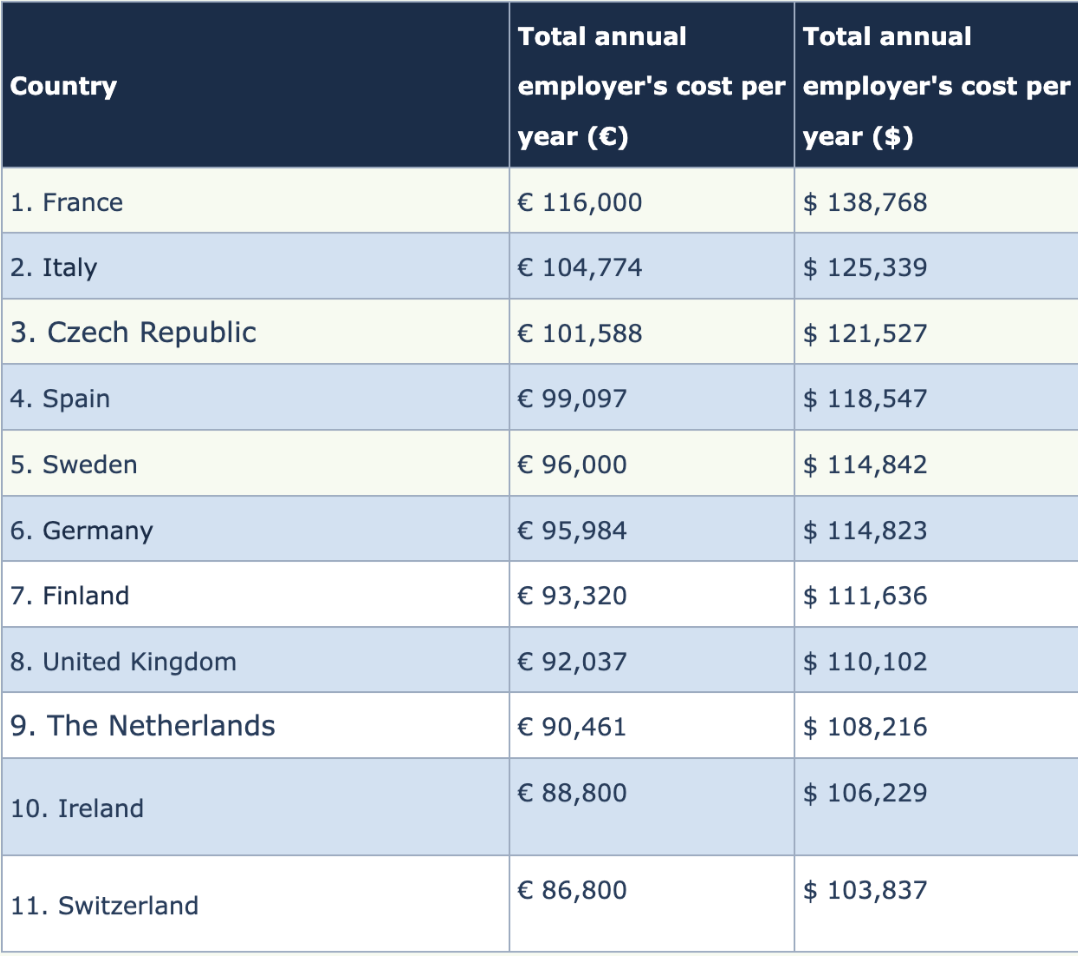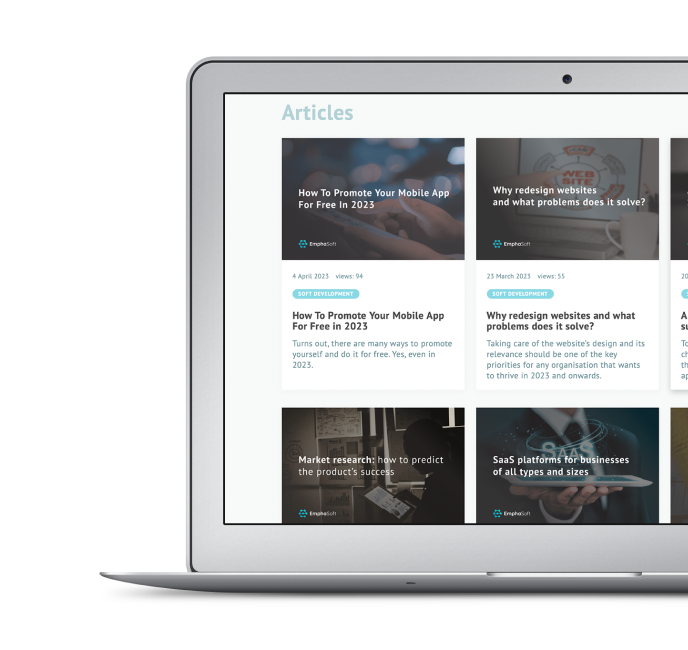It’s no secret that hiring employees is expensive, but quite a bit of that cost is often overlooked. There are many hidden expenses associated with full-time staff that drive up the total cost of maintaining a team.
In this article, we’ll look into all the costs that go into traditional hiring and explore a great alternative to full-time employment – outstaffing. We’ll also identify how and where it can help businesses drive costs down while maximising results.
What goes into the overall cost of hiring a full-time employee?
When we think of hiring someone, the first expense that comes to mind is naturally the salary. In the US, the average cost of a software developer in 2023 is well above 100K, and while that might seem like a lot, there is much more to consider when calculating cost:
#1 The cost of hiring
You start spending money on an employee even before you welcome them to your team. HR needs to post the job offer, review countless CVs, and pick the ones that make the cut to go to the next step. Depending on the role and the internal hiring process, filling the position can take weeks or months, often taking up the time of several employees.
#2 Onboarding and training
Once the employee is hired, you would (hopefully) invest time in proper onboarding to ensure they understand work protocols, are comfortable with the team, and can begin contributing to your organization. But it doesn’t stop there. In order for you to have the best team and maximize their performance, you'll need to provide consistent training and education. Even when you leverage a senior team member to help with training or hiring, it comes at a cost. This study from 2020 found that the average cost of bringing à new hire up to speed is 1100 USD.
Something that isn’t talked about enough is the drop in the team’s productivity when someone joins. Helping a new hire navigate their new workplace or explaining how things work can require several hours a day from your valuable senior resources. All that can use up several hours a day. Multiply that by the number of team members and the days that a newbie is in training, and you end up with thousands of dollars worth of hours invested in your new hire, which can impact you entire team's ability to function at its best.
Slack, one of the world’s most beloved corporate communication messengers, chose to partner with external professionals in their fundraising stages to work on design and app development. As a result, the company was able to skip hiring and onboarding, and released the first version faster, acquiring 15 000 users in only a couple of weeks.
#3 Taxes and mandatory contributions
Depending on your company’s location, taxes and social contributions can take up to 30-40% of the employee’s salary. In the graph below, you see the social contributions dropdown across the European Union with France requiring employers to pay 45% on top of the person’s monthly rate. In fact, the number is rather high across all countries.

#4 Voluntary contributions and benefits
Many companies these days, especially in the technical field, offer expensive benefits to retain their best talent. Gym fees, extended medical insurance, pension contributions, maternity leaves, language courses, free meals – these are all expected by employees with skills and experience. People often leave jobs when they feel they lack adequate benefits.
How to calculate the cost of hiring a full-time employee?
First of all, you should outline everything that goes into hiring a full-time employee. Here are the key factors to consider when calculating new hire costs:
- The salary of a recruiter who will go through resumes and conduct initial interviews (53K USD on average in the US).
- HR agencies’ fees if you choose to outsource hiring (the standard fee is 20% of the candidates’ annual rate).
- Fees and subscriptions on job portals (a basic LinkedIn package for hiring is 180 USD/month and posting a job offer would be 300 USD/month).
- The cost of building and maintaining a career portal on the website with relevant job postings, company info, and cohesive brand design. That should include the number of hours the website team and HR spent identifying what needs to be done and executing the tasks.
- One-off bonuses, such as relocation packages, sign-on, or referral bonuses.
- Office- and workflow-related expenses, such as renting an office space and paying for utilities, coffee and snack supplies, cleaning fees, and work equipment, for example, laptops and servers. Indeed has calculated that the average cost for this is 1.5-3K USD.
- Annual salary of the employee.
Missed profit over the first month or more as the employee ramps up and is not yet generating the output that yields the desired ROI. This cost usually equals one to three monthly salary, depending on the length of the onboarding period.
In addition to all of the above, you want to also understand the costs associated if things don’t go as planned:
- The cost of firing an employee. Depending on the contract and the location, terminating someone who is not a great fit for the company can get expensive. In France, every employee who’s been with the company for over eight months is entitled to severance pay. Most EU countries require a notice period and a plan or procedure to help employees fix the issue that is causing their termination.
- Replacement hiring. Should an employee leave the company or be let go by management, a replacement would be required, which would trigger the standard hiring process and the costs associated with it. In many cases, you would also need to adjust the numbers to accommodate the new, higher rate of specialists similar to the one you’ve just lost.
According to Personio, the yearly cost of employment in the UK equals the annual salary plus 75-100% of the salary on top. And the cost dropdown that they’ve calculated, including recruitment costs, total just over 40 000 GBP. While that number might seem high,it’s an accurate portrayal of all the points we discussed in this article.
EuroDev published a list with total annual employer’s cost per employee, and the numbers look even more impressive:

Looking at hiring alone, the Society for Human Resource Management calculated that, on average, US employers pay approximately 4.4K USD to hire a full-time employee. Note that this is an average across the country, so your hiring cost of niche specialists or highly sought-after professionals can be double and even triple the average.
Calculating the cost of hiring an employee can get tricky, especially if your company is medium to large or you’re using multiple ways of hiring, such as referrals, agencies, and portals. There is a simple formula that doesn’t count the salary of the employee, but rather everything else:
The hiring cost of an employee = Total internal costs associated with hiring + Total external hiring costs / The total number of hired employees
Examples of internal costs are HR salaries and office rental, whereas external costs can be background checks and advertising job openings on relevant portals.
How to calculate the cost of outstaffing employees?
If you are considering outstaffing for your business, you’d need to understand how much it would cost compared to hiring full-time for your team.
Doing the math for outstaffing is easier because the majority of expenses associated with full-time hires simply do not exist with outstaffing. For example, you won’t have to worry about taxes and pension contributions. Training is all carried out by the outsourcing company, and they are the ones doing the hiring.
As a client, you’d only need to consider:
- The cost of finding the right outstaffing partner (number of hours of everyone involved in the due diligence process multiplied by their hourly rates).
- Missed profit during the brief onboarding that usually lasts days (and even hours) compared to months with full-time hires.
- The rate of outstaffed specialists.
- Other payments outlined in the contract.
There are not many case studies with numbers out there because companies do not like to disclose their hiring policies, which is fair. At Emphasoft, we see our clients save up to 70% of the total hiring and employment costs when going with outstaffing.
If you’d like to see how much outstaffing can save you, take the points above, and run the numbers based on your business costs, then divide them by the number of employees you’re looking to outstaff.
The number you’ll end up with is likely to be at least 30% less than compared to standard hiring because you won’t be paying recruitment agencies and referral bonuses, going through an onboarding period, and missing out on profits over that time.
The time saving of outstaffing
Before we sign off, we’d like to stress one point – the immense time savings that outstaffing provides along with economic benefits. Some roles are easy to fill, while others require months of CV scanning and interviews to find the one.
Not only does it drive up the cost of hiring, but also takes precious time of employees who could have been working on other things instead. And we’re not only talking about HR and management.
Team members are often expected to take on extra workload during hiring. What we end up with is a tired team that’s on the verge of burnout because they’ve spent months covering for their missing colleagues. Such employees are not only tired and mistake prone,, but their creative output is often diminished, resulting in lower performance.
This might be the greatest unseen cost of new hires, the toll their onboarding takes on the rest of the team. Timely outstaffing, in turn, can prevent these bad scenarios from happening, and will not only save you a big part of the hiring budget, but will also benefit your project with faster time to market and more desirable results.
Read next:
Why startups should stop hiring people
How to hire the right person fast?

Scale faster with quality tech expertise
Team members are often expected to take on extra workload during hiring. What we end up with is a tired team that’s on the verge of burnout because they’ve spent months covering for their missing colleagues. Such employees are not only tired and mistake prone,, but their creative output is often diminished, resulting in lower performance.
This might be the greatest unseen cost of new hires, the toll their onboarding takes on the rest of the team. Timely outstaffing, in turn, can prevent these bad scenarios from happening, and will not only save you a big part of the hiring budget, but will also benefit your project with faster time to market and more desirable results.








 Schedule a Discovery Call
Schedule a Discovery Call Schedule Call
Schedule Call